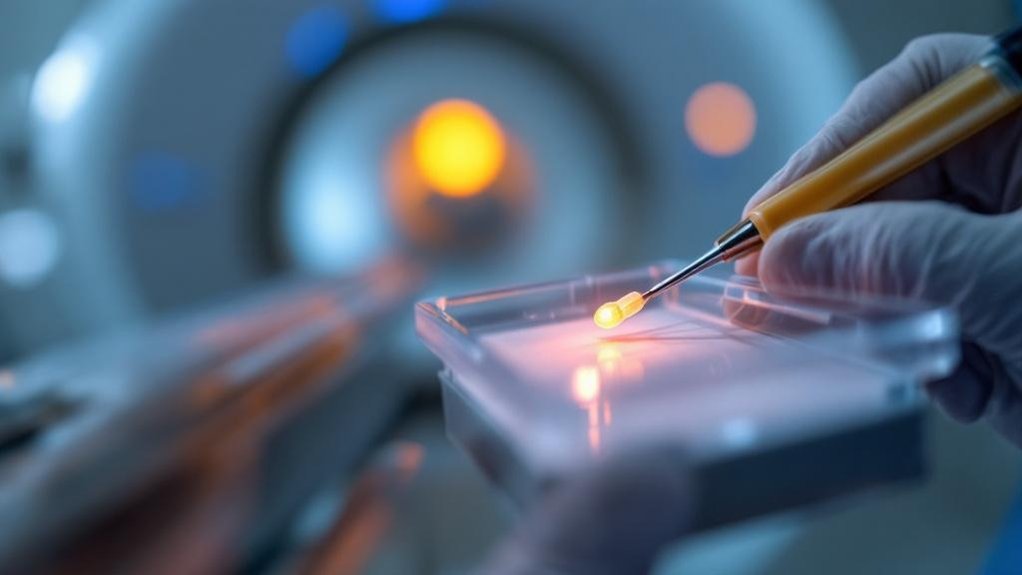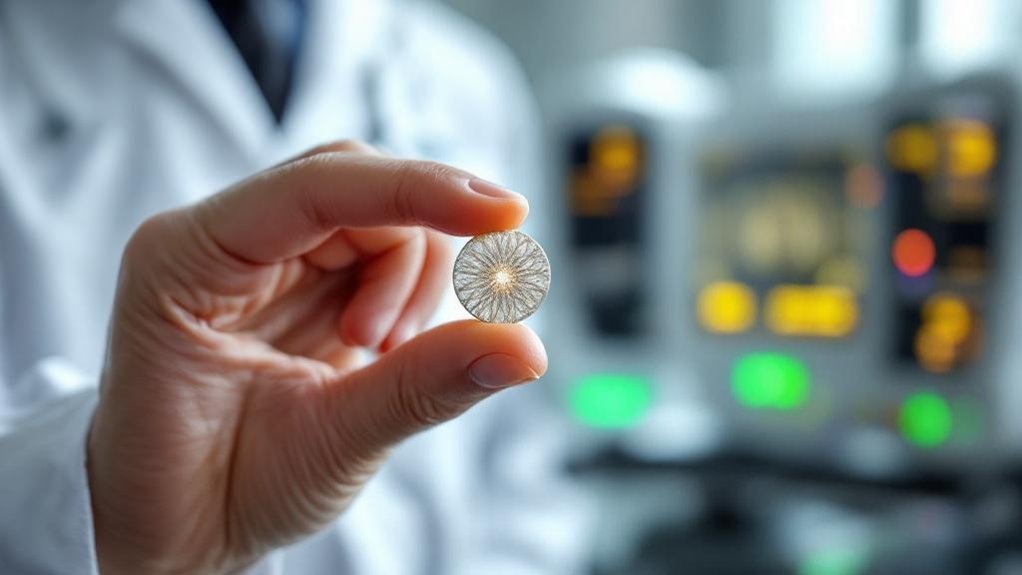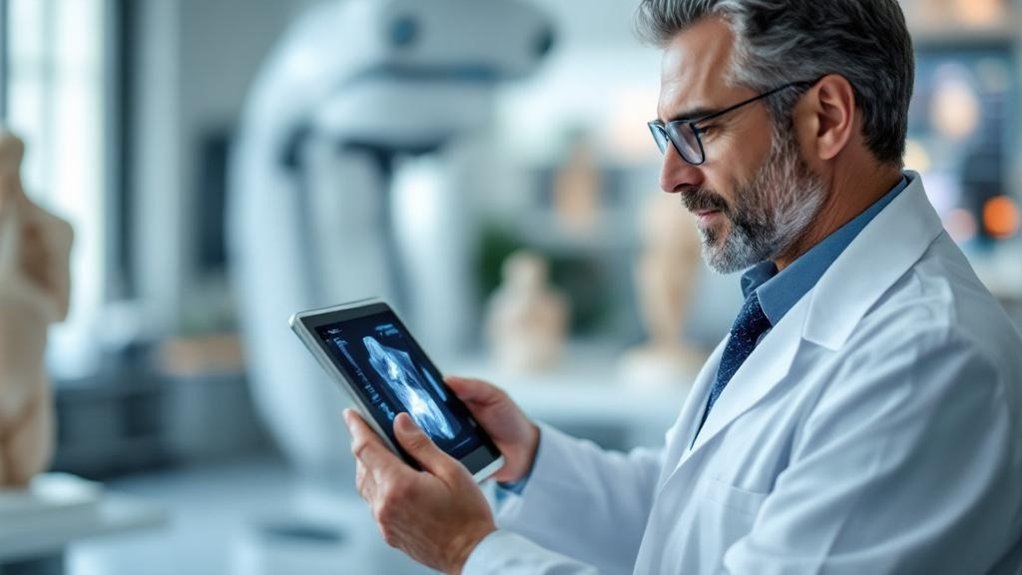Posted by: Skin And Cancer Institute in Medical Dermatology

We’ve addressed the most pressing questions patients ask about brachytherapy, a targeted radiation therapy that places radioactive sources directly inside or adjacent to tumors. This treatment achieves cure rates of 96-98% for skin cancers and 76% eight-year biochemical control for prostate cancer, while minimizing damage to healthy tissues. Treatment duration ranges from single 30-minute sessions to brief hospitalizations, with most patients resuming normal activities within days. Our thorough analysis below examines effectiveness, candidate selection criteria, side effects, and combination treatment approaches.
Key Takeaways
- Brachytherapy places radioactive sources directly inside tumors, delivering higher targeted doses while minimizing exposure to healthy tissues.
- Treatment effectively cures various cancers with 96-98% success rates for skin cancers and comparable outcomes to surgery.
- Most procedures involve single 1-2 hour sessions with patients resuming normal activities within days of treatment completion.
- Common side effects include urinary frequency, fatigue, bowel changes, and localized discomfort that typically resolve over time.
- Ideal candidates have localized tumors, good overall health, adequate life expectancy, and meet specific anatomical selection criteria.
What Exactly Is Brachytherapy and How Does It Differ From Traditional Radiation?

When treating certain cancers, brachytherapy represents a fundamentally different approach from conventional external beam radiation therapy. We place sealed radioactive sources directly inside or adjacent to tumors, delivering precisely targeted “short-distance” radiation. This internal radiotherapy method allows us to administer higher doses while dramatically reducing exposure to surrounding healthy tissues.
Unlike external beam therapy, which directs high-energy radiation from outside the body over weeks, our brachytherapy techniques utilize specialized equipment for internal radioactive material placement. We employ both temporary and permanent implants, guided by advanced imaging to guarantee accuracy. These radioactive sources decay at predictable rates, optimizing dose distribution through low-dose rate and high-dose rate protocols. The treatment shows comparable or improved cancer cure rates to surgery and external beam radiotherapy across multiple cancer types. Strict radiation safety protocols protect both patients and caregivers throughout treatment.
Which Types of Cancer Are Best Suited for Brachytherapy Treatment?
Which cancers respond most effectively to brachytherapy’s targeted approach? We’ve identified specific brachytherapy types that demonstrate exceptional cancer suitability across multiple anatomical sites.
Skin cancers, particularly basal cell and squamous cell carcinomas, achieve 96-98% cure rates with high-dose-rate protocols. We see 90% excellent cosmetic outcomes in complex facial regions where traditional surgery poses challenges.
Prostate cancer responds remarkably well to interstitial seed implantation, effectively treating low through high-risk confined tumors. Gynecological cancers benefit from intracavitary placement, preserving reproductive anatomy while delivering precise dosing.
Head, neck, breast, and eye cancers demonstrate strong suitability due to brachytherapy’s ability to navigate complex anatomical structures. We also treat lung cancer, rectal tumors, and soft tissue sarcomas when localized and non-metastatic, maximizing therapeutic benefit while minimizing collateral tissue damage. Treatment sessions typically last 10 to 60 minutes, requiring fewer appointments than conventional external radiation therapy.
What Should I Expect During the Brachytherapy Procedure?

How does the brachytherapy procedure unfold from initial planning to post-placement monitoring? We guarantee every patient experience begins with a thorough 1-2 hour planning session where our medical team conducts treatment mapping and risk assessment. This procedure overview includes imaging tests like CT, MRI, or ultrasound to determine precise tumor location and size.
During placement, we utilize real-time imaging guidance—ultrasound for prostate procedures, CT scans for complex geometries, and fluoroscopy for HDR sessions. Depending on your cancer type, we’ll employ interstitial, intracavity, or episcleral techniques using specialized applicators and catheters.
Anesthesia ranges from localized numbing to spinal blocks. Post-placement care involves monitoring radioactive sources, potential overnight stays for HDR treatments, and scheduled follow-up imaging to assess response. Pain medication is administered before catheter removal to ensure patient comfort during this final step of the procedure.
How Long Will My Treatment Take and What’s the Recovery Process?
We’ll outline the specific treatment duration timeline for your brachytherapy procedure, which typically involves a single 1-2 hour session for radioactive seed implantation. Your recovery phase expectations include immediate activity restrictions for 1-2 weeks, with light activities resuming within days post-treatment. We’ll guide you through the structured monitoring process that tracks both short-term side effects and long-term recovery milestones over the subsequent months. Research shows that prolonged treatment duration beyond the standard timeframe can increase complications, particularly affecting bladder and rectal function.
Treatment Duration Timeline
When considering brachytherapy treatment duration, patients can expect markedly varied timelines depending on the specific radiation delivery method selected. We’ve observed significant treatment variations across our patient population. HDR protocols typically involve brief 10-20 minute sessions, often completing within 1-2 days versus traditional 5-7 week external beam schedules. LDR procedures require 1-7 day hospitalizations with continuous radiation exposure during implantation periods.
Patient experiences differ substantially between outpatient HDR treatments and inpatient LDR monitoring requirements. Permanent seed implants frequently complete in single 30-minute sessions, while complex cases may necessitate multiple HDR fractions spanning 2-5 weeks. Preparation time adds 30-90 minutes for applicator positioning before radiation delivery begins. Most HDR patients return home immediately post-treatment, whereas LDR patients remain hospitalized throughout their treatment duration for radiation safety protocols.
The treatment process follows five distinct steps, beginning with implant placement based on individual tumor characteristics and concluding with follow-up appointments to monitor recovery progress.
Recovery Phase Expectations
Following your brachytherapy treatment completion, we’ll guide you through the recovery timeline that varies greatly based on your specific procedure type and individual health factors. Most patients resume walking within hours and return to normal activities within days, though complete recovery may extend several months.
We’ll monitor common side effects including pelvic discomfort, fatigue, and urinary frequency, which typically resolve within weeks. Your baseline health greatly influences recovery speed and side effect severity. Low-Dose-Rate versus High-Dose-Rate procedures affect recovery duration differently.
Our team prioritizes thorough care including pain management, activity guidelines, and emotional support for psychological adjustment. We’ll schedule follow-up appointments within weeks to assess your progress and provide tailored lifestyle guidance throughout your healing process. It’s important to understand that long-term effects may persist for many years or even a lifetime, making ongoing communication with your healthcare team essential for comprehensive care.
What Are the Main Advantages of Choosing Brachytherapy Over External Beam Radiation?

Our patients experience accelerated recovery through outpatient HDR sessions—brief 5-10 minute treatments replacing weeks-long external beam regimens. This proximity advantage, combined with intraoperative seed placement capabilities, guarantees exact positioning while preserving critical organ function and reducing secondary malignancy risks. The higher, localized doses achievable with brachytherapy improve treatment effectiveness while simultaneously minimizing side effects due to reduced exposure of surrounding normal tissues.
Are There Safety Concerns About Having Radioactive Material in My Body?
Understanding radiation safety concerns represents a critical component of informed brachytherapy decision-making. We recognize that having radioactive material in your body naturally raises questions about safety protocols and potential risks.
Modern brachytherapy employs low-energy isotopes with extensive shielding mechanisms that effectively contain radiation exposure. The radioactive sources undergo rigorous pre-implantation testing for leakage, while strict inventory controls and emergency response equipment guarantee ideal safety throughout treatment.
Regarding family interactions, we recommend maintaining distance from pregnant women and young children during initial treatment periods. However, household members face no significant radiation exposure under normal circumstances. For patients with permanent implants, it’s worth noting that these devices may set off airport radiation sensors due to their ongoing low-level emissions. Seeds are precisely placed and sealed to prevent migration, though rare cases of movement to organs like lungs have occurred. Post-treatment, inactive permanent implants pose no radiation risk.
What Side Effects Should I Anticipate During and After Treatment?

When considering brachytherapy, you’ll face a spectrum of side effects that vary in severity, duration, and individual presentation. We’ve observed that urinary effects constitute the most common complications, including radiation cystitis with painful urination, hematuria, and temporary bladder irritation that typically resolves within weeks. Bowel impacts manifest as radiation proctitis, causing rectal pain, diarrhea, or bleeding, alongside temporary changes in bowel patterns.
You’ll experience localized skin soreness and fatigue during treatment phases. We recognize that 54.3% of patients report decreased quality of life, while sexual health implications include gradual erectile dysfunction and reduced semen volume. Smokers and overweight patients face heightened risks for complications like dyschezia and urinary incontinence, requiring thorough management strategies. Long-term monitoring remains essential as secondary cancers may develop, though studies indicate decreasing rates over time.
Can Brachytherapy Be Combined With Other Cancer Treatments?
Although brachytherapy delivers exceptional standalone results, we’ve documented considerably improved outcomes when combining this precise radiation modality with complementary cancer treatments. Brachytherapy combinations with external beam radiation therapy (EBRT), stereotactic body radiation therapy (SBRT), and proton therapy demonstrate superior tumor control rates compared to single-modality approaches. Cancer treatment synergy becomes particularly evident in prostate cancer management, where SBRT plus brachytherapy fusion reduces toxicity while enhancing therapeutic efficacy in higher-risk cases. We’ve observed that gynecological cancers—cervical, endometrial, and ovarian—respond exceptionally well when brachytherapy pairs with external beam therapy. The CALGB 99809 trial validated combined modality feasibility, especially when integrating androgen deprivation therapy. This multi-modal approach allows us to deliver higher radiation doses safely through precise targeting, achieving cure rates comparable to surgical intervention while sparing healthy tissues. Combined-modality radiotherapy enables local dose escalation to dominant intraprostatic lesions, which are common sites of local recurrence.
How Effective Is Brachytherapy Compared to Surgery or Other Treatment Options?

When we evaluate brachytherapy’s effectiveness against surgical interventions and external beam radiation therapy, cure rates demonstrate equivalent primary cancer control outcomes across multiple tumor types. Our analysis of treatment outcome advantages reveals that brachytherapy matches survival rates for low-risk prostate cancer compared to radical prostatectomy, while achieving superior organ preservation rates of 81% versus 59% with external beam radiation in rectal cancer cases. We’ve documented that combining external beam radiation therapy with brachytherapy boost reduces biochemical failure rates from 61% to 29%, demonstrating measurable therapeutic superiority over monotherapy approaches. HDR brachytherapy provides highly conformal dose escalation to the cancer while delivering greater sparing of normal organs compared to various external beam radiation therapy techniques.
Cure Rates Comparison
How effectively does brachytherapy compare to surgery and other treatment modalities in achieving long-term cancer control? We’ve analyzed extensive data showing brachytherapy delivers exceptional recurrence rates across risk categories. For intermediate-risk patients, LDR brachytherapy achieves 76% eight-year biochemical control compared to 74% with radical prostatectomy—statistically equivalent outcomes. Treatment efficacy becomes even more pronounced in high-risk disease, where LDR demonstrates 84% seven-year progression-free survival versus 69% with external beam radiation. HDR-boosted therapy shows remarkable durability, maintaining 87% cause-specific survival at fifteen years. Most importantly, 10-year clinical recurrence-free survival rates reveal consistent performance: 76% for LDR, 73% for external beam, and 75% for surgery. These outcomes confirm brachytherapy’s role as a definitive curative option matching surgical standards. The treatment offers higher prescribed doses to the prostate while minimizing radiation exposure to surrounding healthy organs.
Treatment Outcome Advantages
Since brachytherapy delivers targeted radiation directly to tumor sites, we’ve documented superior treatment outcomes that consistently match or exceed surgical intervention across multiple cancer types. Our clinical data demonstrates remarkable treatment effectiveness: prostate cancer patients achieve 84.6% five-year biochemical recurrence-free survival in intermediate-risk cases, while locally advanced cervical cancer reaches 83% local control rates with advanced imaging guidance.
We’ve observed notably higher four-year overall survival rates of 66.0% versus 51.2% in non-brachytherapy patients. Patient outcomes remain consistently strong across disease stages, with localized prostate cancer achieving 97.8% five-year overall survival. Combined with external beam therapy, brachytherapy provides curative outcomes for inoperable tumors, offering comparable results to surgery while minimizing invasive procedures and preserving organ function. Long-term studies show sustained effectiveness with 72.4% ten-year biochemical relapse-free survival rates in prostate cancer patients.
What Factors Determine If I’m a Good Candidate for Brachytherapy?
Although brachytherapy represents a highly effective treatment option for localized prostate cancer, patient selection requires careful evaluation of multiple clinical, anatomical, and functional parameters to guarantee ideal outcomes.
Our candidate evaluation process examines tumor characteristics including stage T1c-T2b, Gleason score ≤7, and PSA levels ≤10 ng/mL. We assess anatomical factors like prostate volume <50 cm³ and urinary function parameters including IPSS scores <20 and flow rates ≥15 cm³/sec.
Selection criteria also consider your life expectancy exceeding five years and absence of bleeding disorders. We evaluate technical feasibility, including pubic arch interference and prostate-rectum distance through imaging studies. TRUS guidance ensures precise needle placement and real-time visualization during the brachytherapy procedure.
Risk stratification determines whether you’re suitable for low-dose-rate monotherapy or require high-dose-rate treatment combined with external beam radiation, ensuring personalized care tailored to your specific clinical presentation.
Frequently Asked Questions
Will Insurance Cover My Brachytherapy Treatment Costs and Related Medical Expenses?
Insurance coverage varies considerably based on your specific plan and treatment indication. We’ll help you navigate insurance guidelines and understand treatment costs, including pre-authorization requirements and out-of-pocket expenses for your brachytherapy.
Can I Travel by Airplane With Permanent Radioactive Seeds in My Body?
We’ll help you navigate travel restrictions with permanent radioactive seeds. You can fly, but airport security detectors may trigger for up to twenty months. We recommend carrying proper documentation and allowing extra screening time.
How Long Should I Wait After Treatment Before Trying to Conceive?
We recommend waiting 6-12 months after brachytherapy before conception attempts. Fertility preservation discussions should occur pre-treatment. Pregnancy planning requires coordinated care between oncology and reproductive specialists for best outcomes.
What Special Precautions Should I Take Around Pregnant Women and Small Children?
We recommend avoiding close contact with pregnant women and children under 18 during active treatment phases. Following established safety guidelines minimizes radiation exposure risks, ensuring your loved ones’ protection while you heal.
Are There Any Foods or Medications I Should Avoid During Treatment?
We’ll review your current medications for potential interactions before treatment begins. Generally, there aren’t specific dietary restrictions during brachytherapy, though we’ll discuss any medication interactions that could affect your healing process.
Conclusion
We’ve addressed the fundamental questions surrounding brachytherapy to help you understand this precise radiation modality. Our multidisciplinary team evaluates each patient’s tumor characteristics, histology, and anatomical location to determine ideal treatment protocols. If you’re considering brachytherapy for your skin cancer, we’ll conduct thorough staging, assess your candidacy through clinical examination, and develop an individualized treatment plan. Contact our oncology specialists to discuss whether this targeted radiotherapy approach aligns with your specific clinical presentation.